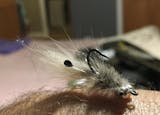Searching for Coyote Fur For Fly Tying? Look No Further!
If you haven’t heard about coyote fur for saltwater flies, you are missing out! Many of you have been asking me where to purchase this fantastic natural material… so here you go!
Coyote fur is quickly becoming one of my favorite materials for bonefish and permit flies for several reasons… and the more I tie with coyote fur, the more I like it. The natural tans, creams, grays, browns and blacks give it an extremely natural look, that blend will with mottled bottoms … just like the creatures that live there.
The guard hairs on coyote fur are average between 2.5 -3 inches long on the back, and up 5 inches long in a patch between the shoulders known as the “mane” or “hackles”. These coarser bristles around the head are excellent for spinning in a dubbing loop and then wrapping to obtain a thick, full body. I use the shorter hair for the wing on bonefish flies, like Squimp, Gotcha’s or Charlie’s. The longer guard hairs closer to the neck and back are often tipped black and are excellent for baby tarpon flies and other baitfish streamers.
Sold in one 5 to 7" piece of soft tanned patch. Coloration varies with individuals and sections. Remember, this is a natural product so exact colors and dimensions may vary.
What make coyote fur so awesome?
I love coyote fur for its natural colors, and durability, but also because it’s stiff wiry texture that allows you to create lifelike flies that don’t foul.
The vast majority of shrimp imitations utilize a synthetic wing material like craft fur, or polar fiber. Most of what you find today in your local fly shop is “extra select” Craft Fur, which has much longer fibers. Even if you pull out the longer fibers in an attempt to create a shorter tapered bundle to tie in for the tail, much of the material is waisted… and after you pick out the underfur from the butts of the material, there just isn’t much left to work with. This stuff is typically all one color (Cream, Tan, etc.) and nothing found in nature is all one color. In an effort to create better more realistic looking crustacean imitations, I started looking back in to natural materials.
At first I experimented with Arctic Fox and Finnish Raccoon, and their soft fibers really move wonderfully in the water. Unfortunately the same characteristics that give it a life like look, also causes it to foul constantly. The answer to this conundrum… Coyote Fur. This canine’s coat may be the perfect bonefish fly material. Not only it slightly stiffer than the previously listed options so it doesn’t foul as easily, but it is also multi colored. Coyote fur has long stiff guard hairs, that become supple when wet, and it’s soft under is perfect for dubbing.
Long story short, coyote fur for tying saltwater flies is a winner! … It’s just about perfect for any shrimp/crustacean fly you want to tie.
What’s the difference between Coyote fur and Coyote Tail?
The Difference Between Coyote Tail & Fur is Color, Length & Texture.
The bushy coyote tail is a beautiful blend of cream’s, tan’s, gray’s, rush brown’s and black colors. The hairs are longer (4-5″) and finer with a dense underfur.
Coyote Fur has shorter, stiffer guard hairs and a soft underfur. The color still varies, but the vast majority is more cream grays and blacks.








